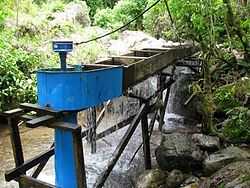Pico hydro

Pico hydro is a term used for hydroelectric power generation of under 5 kW. It is useful in small, remote communities that require only a small amount of electricity - for example, to power one or two fluorescent light bulbs and a TV or radio in 50 or so homes.[2] Even smaller turbines of 200-300W may power a single home in a developing country with a drop of only 1 meter. Pico-hydro setups typically are run-of-stream, meaning that dams are not used, but rather pipes divert some of the flow, drop this down a gradient, and through the turbine before being exhausted back to the stream.
Like other hydroelectric and renewable source power generation, pollution and consumption of fossil fuels is reduced, though there is still typically an environmental cost to the manufacture of the generator and distribution methods.
Manufacturers
Two examples of pico hydro power can be found in the towns of Kithamba and Thimba in the Central Province of Kenya. These produce 1.1 kW and 2.2 kW, respectively. Local residents were trained to maintain the hydro schemes. The pico hydro sites in Kenya won Ashden Awards for Sustainable Energy.[3]
In Vietnam, several Chinese manufacturers have sold pico-powerplants at prices as low as $20–$70 for a powerplant of 300-500W. However, the devices sold are said to be low in quality and may damage connected equipment if connected improperly.[4]
Sam Redfield of the Appropriate Infrastructure Development Group (AIDG) has developed a pico-hydro generator made from common PVC pipe and a modified Toyota alternator housed in a five gallon bucket. The generator was developed to provide power to communities without access to the electricity grid in developing countries. Envisioned as an energy source to charge cell phones, provide lighting and charge batteries, the generator is designed to be made by artisans with basic skills and can be built for less than US $150.00. The Toyota alternator used in the generator is converted to a permanent magnet alternator allowing it to generate power at low RPMs. The Five Gallon Bucket Hydroelectric Generator was the subject of a work group at the 2008 International Development Design Summit (IDDS) at the Massachusetts Institute of Technology. During the Summer of 2013 an energy project in Abra Malaga, Peru was completed using the bucket generator.[5]
A website has been put together as a forum for ideas and further iterations of the generator that includes a build manual.[6]
See also
- Small hydro
- Micro hydro
- Hydro power
- Renewable Energy
- Sustainable energy
External links
- "What is Pico Hydro?". Pico hydro publications. University of Nottingham, UK. Retrieved 6 September 2010.
- Mattijs Smits. "Technography of pico-hydropower in the Lao PDR". The Lao Institute for Renewable Energy (LIRE). Retrieved 6 September 2010.
References
- ↑ "Pico-Hydropower Franchising: A Test Bed in Rural Honduras". National Collegiate Inventors and Innovators Alliance. Retrieved 24 January 2013.
- ↑ "Micro Hydro Project". Technologies for Conservation & Development project. Retrieved 6 September 2010.
- ↑ "Ashden Award for Pico hydro power in Kenya". Ashden Awards. Retrieved 6 September 2010.
- ↑ Shahidur R. Khandker, Douglas F. Barnes, Hussain Samad, Nguyen Huu Minh (September 2008). "Welfare Impacts of Rural Electrification: Evidence from Vietnam". World Bank. Retrieved 6 September 2010.
- ↑ "Five Gallon Bucket". Retrieved 2012-06-20.
- ↑ Sam Redfield. "Five Gallon Bucket Hydroelectric Generator Build Manual". Appropriate Infrastructure Development Group. Engineering for Change. Retrieved 2012-06-20.
| |||||